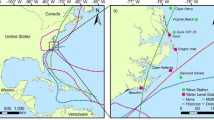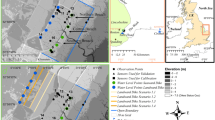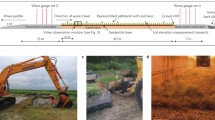Abstract
Coastal wetlands are receiving increased consideration as natural defenses for coastal communities from storm surge. However, there are gaps in storm surge measurements collected in marsh areas during extreme events as well as understanding of storm surge processes. The present study evaluates the importance and variation of different processes (i.e., wave, current, and water level dynamics with respect of the marsh topography and vegetation characteristics) involved in a storm surge over a marsh, assesses how these processes contribute to storm surge attenuation, and quantifies the storm surge attenuation in field conditions. During the Fall of 2015, morphology and vegetation surveys were conducted along a marsh transect in a coastal marsh located at the mouth of the Chesapeake Bay, mainly composed of Spartina alterniflora and Spartina patens. Hydrodynamic surveys were conducted during two storm events. Collected data included wave characteristics, current velocity and direction, and water levels. Data analysis focused on the understanding of the cross-shore evolution of waves, currents and water level, and their influence on the overall storm surge attenuation. Results indicate that the marsh area, despite its short length, attenuates waves and reduces current velocity and water level. Tides have a dominant influence on current direction and velocity, but the presence of vegetation and the marsh morphology contribute to a strong reduction of current velocity over the marsh platform relative to the currents at the marsh front. Wave attenuation varies across the tide cycle which implies a link between wave attenuation and water level and, consequently, storm surge height. Storm surge reduction, here assessed through high water level (HWL) attenuation, is linked to wave attenuation across the front edge of the marsh; this positive trend highlights the reduction of water level height induced by wave setup reduction during wave propagation across the marsh front edge. Water level attenuation rates observed here have a greater range than the rates observed or modeled by other authors, and our results suggest that this is linked to the strong influence of waves in storm surge attenuation over coastal areas.









Similar content being viewed by others
References
Ackerman, J.D., and A. Okubo. 1993. Reduced mixing in a marine Macrophyte canopy. Functional Ecology 7: 305–309. doi:10.2307/2390209.
Anderson, M.E., and J.M. Smith. 2014. Wave attenuation by flexible, idealized salt marsh vegetation. Coastal Engineering 83: 82–92. doi:10.1016/j.coastaleng.2013.10.004.
Arkema, K.K., G. Guannel, G. Verutes, S.A. Wood, A. Guerry, M. Ruckelshaus, P. Kareiva, M. Lacayo, and J.M. Silver. 2013. Coastal habitats shield people and property from sea-level rise and storms. Nature Climate Change 3: 913–918. doi:10.1038/nclimate1944.
Boller, M.L., and E. Carrington. 2006. In situ measurements of hydrodynamic forces imposed on Chondrus crispus Stackhouse. Journal of Experimental Marine Biology and Ecology 337: 159–170. doi:10.1016/j.jembe.2006.06.011.
Bouma, T.J., M.B. De Vries, E. Low, G. Peralta, I.C. Tanczos, J. Van de Koppel, and P.M.J. Herman. 2005. Trade-offs related to ecosystem engineering: a case study on stiffness of emerging macrophytes. Ecology 86: 2187–2199.
Bouma, T.J., J. van Belzen, T. Balke, Z. Zhu, L. Airoldi, A.J. Blight, A.J. Davies, C. Galvan, S.J. Hawkins, S.P.G. Hoggart, J.L. Lara, I.J. Losada, M. Maza, B. Ondiviela, M.W. Skov, E.M. Strain, R.C. Thompson, S. Yang, B. Zanuttigh, L. Zhang, and P.M.J. Herman. 2014. Identifying knowledge gaps hampering application of intertidal habitats in coastal protection: opportunities & steps to take. Coastal Engineering 87: 147–157. doi:10.1016/j.coastaleng.2013.11.014.Coasts@Risks: THESEUS, a new wave in coastal protection
Bradley, K., Houser, C. 2009. Relative velocity of seagrass blades : Implications for wave attenuation in low-energy environments. Journal of Geophysical Research - Earth Surface 114. doi :10.1029/2007JF000951.
Bridges, T.S., Wagner, P.W., Burks-Copes, K.A., Bates, M., Collier, Z.A. 2015. Use of natural and nature-based features (NNBF) for coastal resilience (Final Report No. ERDC SR-15-1). USACE-ERDC
Committee on Environment, Natural, Resources, and Sustainability, National Science and Technology Council. 2015. Ecosystem-service assessment: research needs for coastal green infrastructure. Executive Office of the President of the United States
Corps of Engineers, US Army Engineer District. 1963. Interim survey report: Morgan City, Louisiana and vicinity (No. Serial no. 63). New Orleans, Louisiana
Coulombier, T., U. Neumeier, and P. Bernatchez. 2012. Sediment transport in a cold climate salt marsh (St. Lawrence estuary, Canada), the importance of vegetation and waves. Estuarine, Coastal and Shelf Science 101: 64–75. doi:10.1016/j.ecss.2012.02.014.
Fonseca, M.S., and W.J. Kenworthy. 1987. Environmental impacts on seagrasses effects of current on photosynthesis and distribution of seagrasses. Aquatic Botany 27: 59–78. doi:10.1016/0304-3770(87)90086-6.
Fonseca, M.S., J.S. Fisher, J.C. Zieman, and G.W. Thayer. 1982. Influence of the seagrass, Zostera marina L., on current flow. Estuarine, Coastal and Shelf Science 15: 351–364. doi:10.1016/0272-7714(82)90046-4.
Gedan, K.B., M.L. Kirwan, E. Wolanski, E.B. Barbier, and B.R. Silliman. 2011. The present and future role of coastal wetland vegetation in protecting shorelines: answering recent challenges to the paradigm. Climatic Change 106: 7–29. doi:10.1007/s10584-010-0003-7.
Ghisalberti, M., and H.M. Nepf. 2002. Mixing layers and coherent structures in vegetated aquatic flows. Journal of Geophysical Research, Oceans 107: 3–1. doi:10.1029/2001JC000871.
Ghisalberti, M., and H. Nepf. 2009. Shallow flows over a permeable medium: the hydrodynamics of submerged aquatic canopies. Transport in Porous Media 78: 309–326. doi:10.1007/s11242-008-9305-x.
Horikawa, K. 1988. Nearshore dynamics and coastal processes : theory, measurement and predictive models, 1–522. Tokyo: University of Tokyo Press.
Hu, K., Q. Chen, and H. Wang. 2015. A numerical study of vegetation impact on reducing storm surge by wetlands in a semi-enclosed estuary. Coastal Engineering 95: 66–76. doi:10.1016/j.coastaleng.2014.09.008.
Jadhav, R., and Q. Chen. 2012. Field investigation of wave dissipation over salt marsh vegetation during tropical cyclone. Coastal Engineering Proceedings 1(33): 41. doi:10.9753/icce.v33.waves.41.
Jago, O.K., Kench, P.S., Brander, W.S. 2007. Field observations of wave-driven water-level gradients across a coral reef flat. Journal of Geophysical Research - Oceans 112. doi:10.1029/2006JC003740.
John, B.M., K.G. Shirlal, and S. Rao. 2015. Effect of artificial vegetation on wave attenuation – an experimental investigation. Procedia Eng. 116: 600–606. doi:10.1016/j.proeng.2015.08.331.
Knutson, P.L., R.A. Brochu, W.N. Seelig, and M. Inskeep. 1982. Wave damping Inspartina alterniflora marshes. Wetlands 2: 87–104. doi:10.1007/BF03160548.
Koch, E.W. 1999. Sediment resuspension in a shallow Thalassia testudinum banks ex König bed. Aquatic Botany 65: 269–280.
Koch, E.W., E.B. Barbier, B.R. Silliman, D.J. Reed, G.M. Perillo, S.D. Hacker, E.F. Granek, J.H. Primavera, N. Muthiga, S. Polasky, B.S. Halpern, C.J. Kennedy, C.V. Kappel, and E. Wolanski. 2009. Non-linearity in ecosystem services: temporal and spatial variability in coastal protection. Frontiers in Ecology and the Environment 7: 29–37. doi:10.1890/080126.
Krauss, K.W., T.W. Doyle, T.J. Doyle, C.M. Swarzenski, A.S. From, R.H. Day, and W.H. Conner. 2009. Water level observations in mangrove swamps during two hurricanes in Florida. Wetlands 29: 142–149. doi:10.1672/07-232.1.
Lara, J.L., M. Maza, B. Ondiviela, J. Trinogga, I.J. Losada, T.J. Bouma, and N. Gordejuela. 2016. Large-scale 3-D experiments of wave and current interaction with real vegetation. Part 1: guidelines for physical modeling. Coastal Engineering 107: 70–83. doi:10.1016/j.coastaleng.2015.09.012.
Lavoie, R., J. Deslandes, and F. Proulx. 2016. Assessing the ecological value of wetlands using the MACBETH approach in Quebec City. Journal for Nature Conservation 30: 67–75. doi:10.1016/j.jnc.2016.01.007.
Leonard, L.A., and A.L. Croft. 2006. The effect of standing biomass on flow velocity and turbulence in Spartina alterniflora canopies. Estuarine, Coastal and Shelf Science 69: 325–336. doi:10.1016/j.ecss.2006.05.004.Salt Marsh Geomorphology: Physical and ecological effects on landform
Leonard, L.A., and M.E. Luther. 1995. Flow hydrodynamics in tidal marsh canopies. Limnology and Oceanography 40: 1474–1484. doi:10.4319/lo.1995.40.8.1474.
Leonard, L.A., A.C. Hine, and M.E. Luther. 1995. Surficial sediment transport and deposition processes in a Juncus roemerianus marsh, west-Central Florida. Journal of Coastal Research 11: 322–336.
Loder, N.M., J.L. Irish, M.A. Cialone, and T.V. Wamsley. 2009. Sensitivity of hurricane surge to morphological parameters of coastal wetlands. Estuarine, Coastal and Shelf Science 84: 625–636. doi:10.1016/j.ecss.2009.07.036.
Lott, N., Ross, T. 2006. 1.2 Tracking and evaluating US billion dollar weather disasters, 1980–2005. Retrieved on March
Lovelace, J.K., 1994. Storm-tide elevations produced by hurricane Andrew along the Louisiana Coast, August 25–27, 1992 (No. 94–371). U.S. Geological Survey
Marsooli, R., and W. Wu. 2014. Numerical investigation of wave attenuation by vegetation using a 3D RANS model. Advances in Water Resources 74: 245–257. doi:10.1016/j.advwatres.2014.09.012.
Maza, M., J.L. Lara, I.J. Losada, B. Ondiviela, J. Trinogga, and T.J. Bouma. 2015. Large-scale 3-D experiments of wave and current interaction with real vegetation. Part 2: experimental analysis. Coastal Engineering 106: 73–86. doi:10.1016/j.coastaleng.2015.09.010.
McGee, B.D., Tollett, R.W., Goree, B.B., Farris, G.S., Smith, G.J., Crane, M.P., Demas, C.R., Robbins, L.L., Lavoie, D.L. 2005. Monitoring Hurricane Rita inland storm surge. Science and the Storms: the USGS Response to the Hurricane 257–263
McGee, B.D., Goree, B.B., Tollett, R.W., Woodward, B.K., Kress, W.H., 2006. Hurricane Rita surge data, Southwestern Louisiana and Southeastern Texas, September to November 2005. US Geological Survey Data Series 220. https://pubs.usgs.gov/ds/2006/220/.
Möller, I., T. Spencer, J.R. French, D. Leggett, and M. Dixon. 1999. Wave transformation over salt marshes: a field and numerical modelling study from North Norfolk, England. Estuarine, Coastal and Shelf Science 49: 411–426.
Möller, I., M. Kudella, F. Rupprecht, T. Spencer, M. Paul, B.K. van Wesenbeeck, G. Wolters, K. Jensen, T.J. Bouma, M. Miranda-Lange, and S. Schimmels. 2014. Wave attenuation over coastal salt marshes under storm surge conditions. Nature Geoscience 7: 727–731. doi:10.1038/ngeo2251.
Nepf, H.M. 1999. Drag, turbulence, and diffusion in flow through emergent vegetation. Water Resources Research 35: 479–489.
Nepf, H.M. 2012. Flow and transport in regions with aquatic vegetation. Annual Review of Fluid Mechanics 44: 123–142. doi:10.1146/annurev-fluid-120710-101048.
Neumeier, U. 2007. Velocity and turbulence variations at the edge of saltmarshes. Continental Shelf Research 27: 1046–1059. doi:10.1016/j.csr.2005.07.009.
Neumeier, U., Ciavola, P. 2004. Flow resistance and associated sedimentary processes in a Spartina maritima Salt-Marsh. Journal of Coastal Research 435–447. doi:10.2112/1551-5036(2004)020[0435:FRAASP]2.0.CO;2
Paul, M., and C.L. Amos. 2011. Spatial and seasonal variation in wave attenuation over Zostera noltii. J. Geophys. Res.-Oceans 116: C08019. doi:10.1029/2010JC006797.
Paul, M., T. Bouma, and C. Amos. 2012. Wave attenuation by submerged vegetation: combining the effect of organism traits and tidal current. Marine Ecology Progress Series 444: 31–41. doi:10.3354/meps09489.
Peralta, G., L. van Duren, E. Morris, and T. Bouma. 2008. Consequences of shoot density and stiffness for ecosystem engineering by benthic macrophytes in flow dominated areas: a hydrodynamic flume study. Marine Ecology Progress Series 368: 103–115. doi:10.3354/meps07574.
Perry, J.E., Barnard, T.A., Bradshaw, J.G., Friedrichs, C.T., Havens, K.J., Mason, P.A., Priest, W.I., Silberhorn, G.M. 2001. Creating Tidal Salt Marshes in the Chesapeake Bay. Journal of Coastal Research 170–191
Resio, D.T., and J.J. Westerink. 2008. Modeling the physics of storm surges. Physics Today 61: 33–38. doi:10.1063/1.2982120.
Sénéchal, N., H. Dupuis, P. Bonneton, H. Howa, and R. Pedreros. 2001. Observation of irregular wave transformation in the surf zone over a gently sloping sandy beach on the French Atlantic coastline. Oceanologica Acta 24: 545–556.
Sheng, Y.P., A. Lapetina, and G. Ma. 2012. The reduction of storm surge by vegetation canopies: three-dimensional simulations. Geophysical Research Letters 39: L20601. doi:10.1029/2012GL053577.
Shepard, C.C., C.M. Crain, and M.W. Beck. 2011. The protective role of coastal marshes: a systematic review and meta-analysis. PloS One 6: e27374. doi:10.1371/journal.pone.0027374.
Spalding, M.D., A.L. McIvor, M.W. Beck, E.W. Koch, I. Möller, D.J. Reed, P. Rubinoff, T. Spencer, T.J. Tolhurst, T.V. Wamsley, B.K. van Wesenbeeck, E. Wolanski, and C.D. Woodroffe. 2014a. Coastal ecosystems: a critical element of risk reduction. Conservation Letters 7: 293–301. doi:10.1111/conl.12074.
Spalding, M.D., S. Ruffo, C. Lacambra, I. Meliane, L.Z. Hale, C.C. Shepard, and M.W. Beck. 2014b. The role of ecosystems in coastal protection: adapting to climate change and coastal hazards. Ocean and Coastal Management 90: 50–57. doi:10.1016/j.ocecoaman.2013.09.007.
Stark, J., T. Van Oyen, P. Meire, and S. Temmerman. 2015. Observations of tidal and storm surge attenuation in a large tidal marsh. Limnology and Oceanography 60: 1371–1381. doi:10.1002/lno.10104.
Stark, J., Y. Plancke, S. Ides, P. Meire, and S. Temmerman. 2016. Coastal flood protection by a combined nature-based and engineering approach: modeling the effects of marsh geometry and surrounding dikes. Estuarine, Coastal and Shelf Science 175: 34–35. doi:10.1016/j.ecss.2016.03.027.
Sutton-Grier, A.E., K. Wowk, and H. Bamford. 2015. Future of our coasts: the potential for natural and hybrid infrastructure to enhance the resilience of our coastal communities, economies and ecosystems. Environmental Science & Policy 51: 137–148. doi:10.1016/j.envsci.2015.04.006.
Thomas, R.E., M.F. Johnson, L.E. Frostick, D.R. Parsons, T.J. Bouma, J.T. Dijkstra, O. Eiff, S. Gobert, P.-Y. Henry, P. Kemp, S.J. Mclelland, F.Y. Moulin, D. Myrhaug, A. Neyts, M. Paul, W.E. Penning, S. Puijalon, S.P. Rice, A. Stanica, D. Tagliapietra, M. Tal, A. Tørum, and M.I. Vousdoukas. 2014. Physical modelling of water, fauna and flora: knowledge gaps, avenues for future research and infrastructural needs. Journal of Hydraulic Research 52: 311–325. doi:10.1080/00221686.2013.876453.
Tschirky, P., Hall, K., Turcke, D. 2001. Wave attenuation by emergent wetland vegetation. In: Coastal engineering conference. ASCE American Society Of Civil Engineers, pp. 865–877
Wamsley, T.V., M.A. Cialone, J.M. Smith, J.H. Atkinson, and J.D. Rosati. 2010. The potential of wetlands in reducing storm surge. Ocean Engineering 37: 59–68. doi:10.1016/j.oceaneng.2009.07.018.A Forensic Analysis of Hurricane Katrina’s Impact: Methods and Findings
Ward, L.G., W. Michael Kemp, and W.R. Boynton. 1984. The influence of waves and seagrass communities on suspended particulates in an estuarine embayment. Marine Geology 59: 85–103. doi:10.1016/0025-3227(84)90089-6.
Wu, F.-C., H.W. Shen, and Y.-J. Chou. 1999. Variation of roughness coefficients for Unsubmerged and submerged vegetation. Journal of Hydraulic Engineering 125: 934–942. doi:10.1061/(ASCE)0733-9429(1999)125:9(934).
Xue, B., M. Keming, Y. Liu, Z. Jieyu, and Z. Xiaolei. 2008. Differences of ecological functions inside and outside the wetland nature reserves in Sanjiang plain. China. Acta Ecol. Sin. 28: 620–626. doi:10.1016/S1872-2032(08)60028-1.
Zhang, K., H. Liu, Y. Li, H. Xu, J. Shen, J. Rhome, and T.J. Smith III. 2012. The role of mangroves in attenuating storm surges. Estuarine, Coastal and Shelf Science 102–103: 11–23. doi:10.1016/j.ecss.2012.02.021.
Acknowledgments
The authors are grateful to the referees for their time and effort in providing constructive input. This material is based upon work supported by the National Fish and Wildlife Foundation and the US Department of the Interior under Grant No. 43932. The views and conclusions contained in this document are those of the authors and should not be interpreted as representing the opinions or policies of the US Government or the National Fish and Wildlife Foundation and its funding sources. Mention of trade names or commercial products does not constitute their endorsement by the US Government, or the National Fish and Wildlife Foundation or its funding sources. This material is also based upon work supported by the National Science Foundation under Grant No. SES-1331399. Any opinions, findings, and conclusions or recommendations expressed in this material are those of the authors and do not necessarily reflect the views of the National Science Foundation. This research was also supported in part by the Thomas F. and Kate Miller Jeffress Memorial Trust, Bank of America, Trustee.
Author information
Authors and Affiliations
Corresponding author
Additional information
Communicated by David K. Ralston
Rights and permissions
About this article
Cite this article
Paquier, AE., Haddad, J., Lawler, S. et al. Quantification of the Attenuation of Storm Surge Components by a Coastal Wetland of the US Mid Atlantic. Estuaries and Coasts 40, 930–946 (2017). https://doi.org/10.1007/s12237-016-0190-1
Received:
Revised:
Accepted:
Published:
Issue Date:
DOI: https://doi.org/10.1007/s12237-016-0190-1




